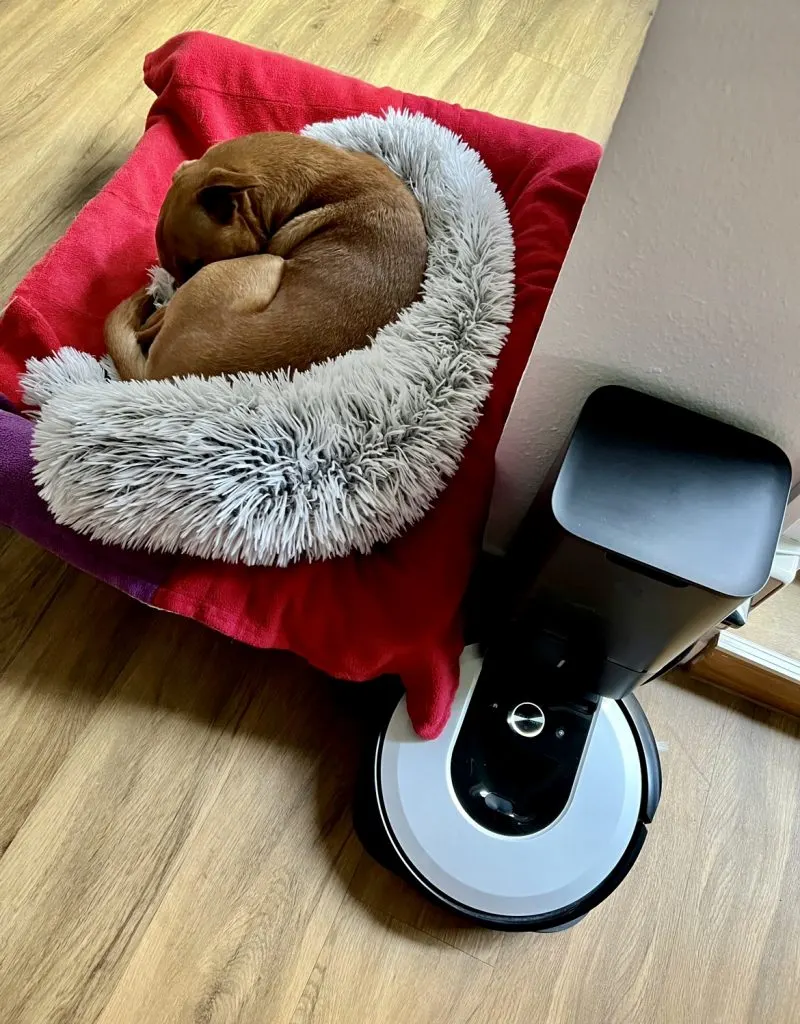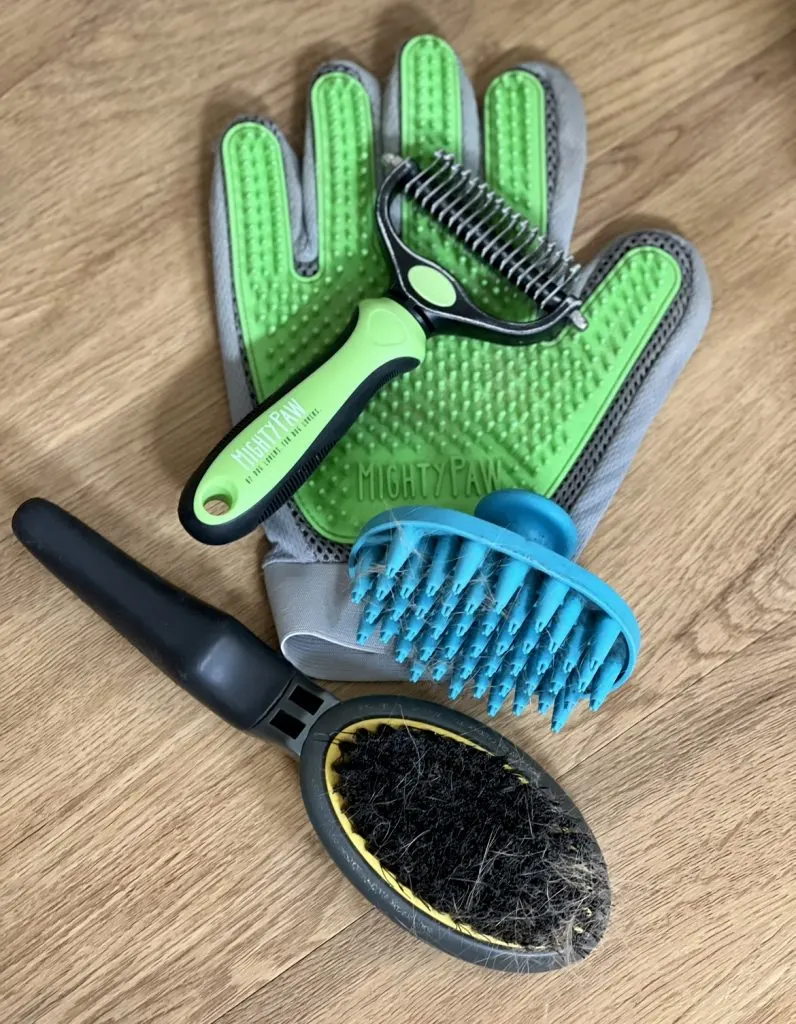Yep, we can probably all agree that shed happens in dog homes, but the question is how to stop a dog from shedding? or at least keep the fur out of my food…ack!
Before we answer this question, it’s important to understand that almost all dogs shed naturally, and we’ll go into the reasons for shedding throughout this article.
Thankfully, there are smart tools to help manage your dog’s loose hair around your home, and we’ll share our best finds with you.
Additionally, we’ll cover tactics that help reduce dog shedding, both in short haired dogs and long haired pups.
Finally, we list certain illnesses that cause excessive shedding and warrant a trip to your vet.
Ready, shed, go!
Why Do Dogs Shed?
So first things first, why do dogs shed?
Well, shedding is normal for almost all dogs because it’s how they get rid of old and loose hair.
Exceptions to this rule are hairless dog breeds, for example the:
- American Hairless Terrier
- Peruvian Inca Orchid
- Xoloitzcuintli
- Chinese Crested
- Hairless Chihuahua
- Abyssinian Sand Terrier
But for pups with hair, dog shedding seasons are spring and fall.
During spring, your dog’s coat becomes lighter to prepare for the warmer weather. Likewise during fall, your dog’s coat becomes thicker to prepare for colder temperatures.
Poor Dog Grooming Hygiene
All dogs benefit from regular grooming including brushing and bathing as they help reduce hair shedding, so make time for both!
It also strengthens the bond between your pup and yourself because you spend quality time together, so what’s not to love?
However, while bathing your dog gets rid of hair, be careful not to bathe your pup too frequently. This can dry out their skin because over bathing gets rid of your dog’s natural oils and promotes a dull coat.
That said, you can safely bathe your dog every 4-6 weeks. If they’re a long-haired breed, they’ll benefit from hair cutting every 8-12 weeks.
Dog Allergies & Poor Nutrition
Food allergies, seasonal allergies and a diet lacking in healthy nutrients can all cause severe itching in dogs.
This results in excessive scratching and leads to hair loss. If it’s really bad, it can even cause bald spots in your dog’s coat.
Common triggers for food allergies in dogs are grains and farmed chickens because they’re mostly fed a diet consisting of grains and corn.
They’re rich in Omega-6 fatty acids which are known to cause inflammation in the body.
Common triggers for seasonal allergies are pollen, mold and dust. Some dogs are also allergic to cigarette smoke.
Parasites Like Fleas, Mites & Lice
Likewise, parasites like fleas, mites and lice can also contribute to excessive shedding.
That’s because they cause itching and scratching.
Stress & Lack of Hydration
Shedding can also increase when your dog is anxious and stressed.
For example, after the addition of a new (furry) family member, moving to a new area or consistent loud noise they’re not used to such as during a home remodel.
When Colby was raising his first guide dog puppy, Stetson one of the other guide pups, Naomi was dropped during advanced training because she was shedding excessively due to the stress of being a guide dog.
Additionally, if your pup doesn’t drink enough water, it affects their skin and coat health and contributes to dog shedding. That’s why it’s important to allow your dog access to fresh, clean drinking water.
If they’re not big on drinking from their water bowl, you could try a more “playful” bowl such as a pet fountain. You can also mix water in with their (dry) dog food or top it off with nourishing bone broth!
Pregnancy & Lactation
Pregnancy and lactation can also cause excessive shedding in female dogs.
That’s especially true if they don’t get the right diet to help make up for their increased nutrient needs during this time.
Female dogs can also shed more after their heat cycle.
Tools to Help Manage Your Dog’s Shedding
Before we look at how to reduce shedding in dogs, let’s quickly cover tools that can help avoid dog hair tumbleweeds taking over your home!
Pet Hair Vacuums
Vacuuming and/or mopping your floors multiple times a week is a no-brainer when you’re dealing with excessive dog hair around the house.
That said, the right vacuum can cause less frustration, so look into buying a vacuum cleaner that’s built to handle pet hair.
For example:
- Dyson V11 Animal Cordless Vacuum Cleaner
- BISSELL 27909 Pet Hair Easer Turbo Rewind Vacuum
- Eureka PowerSpeed Bagless Upright Vacuum Cleaner Pet Turbo
- Shark NV356E 31 Navigator Lift-Away Professional Upright Vacuum (Pet Power)
You can also invest in a vacuum robot that cleans your home on a daily basis.
While it’s not perfect and can’t reach all corners, it’s a nice way of reducing the amount of work you have to put in yourself.
It’s what I did and I can’t even begin to tell you how much I love my iRobot Roomba i7! Besides doing a good job at picking up my dog Wally’s hair, it also picks up mine, so it’s a win-win.
It comes with automatic dirt removal (empties itself) and you can even remote control it with an app on your phone.
Dog Furniture Covers
If you’re not crazy about having your furniture covered in dog hair but still want to allow your pup on your couch and bed, look into covering them.
You can either use large blankets, towels, or specific furniture protector covers for pets such as any of the following:
- Easy Going Reversible Couch Cover for Dogs
- PureFit Reversible Quilted Sofa Cover for Dogs
- Furhaven Snuggly Spot Furniture Seat Protector
Obviously dog hair is still going to accumulate on them, but it’s easy enough to shake them out or throw them into the wash.
Pet Hair Remover Tools
Alternatively or additionally, you can also use specific pet hair remover tools, garment brushes, lint rollers and pet hair rollers.
You can also use rubber brooms to clean up pet hair. They work on carpeted areas, hardwood and tile floors.
What Helps Reduce Shedding in Dogs?
Now that you know how to manage your dog’s loose hair at home, let’s look at approaches that will reduce dog shedding.
Using The Right Dog Brush
If you’re serious about reducing your pup’s shedding, you’ll have to brush your dog frequently, to the tune of 2-3 times per week or even several times daily during shedding season!
Besides bathing and blow drying, that’s the number one tip that dog groomers share do stop shedding, in the following order:
- Brush
- Bathe
- Blow dry
- Brush again
But in order to get the best results, you’ll have to make sure to use the right brush for your particular dog’s coat:
- Rubber Hand Brush or Brushing Glove. Both remove loose surface hair and massage the skin. Great for short haired dogs like Boxers, Bulldogs, Beagles, Weimaraners, Rottweilers, GSPs, etc.
- Short, tough Bristle Brush. Used to finish off short-haired dog coats.
- Long, soft Bristle Brush. Used to finish off long-haired dogs with silky hair like Afghan Hounds or Long-Haired Yorkshire Terriers.
- Slicker Brush aka Pin Brush. For medium-long haired dogs and dogs with curly hair to remove minor mats and knots as well as loose hair.
- Undercoat Rake. For dogs with thick undercoats like Newfoundlands, Huskies, Akitas, Pomeranians, Chow Chows, Old English Sheepdogs, Samoyeds, etc. They remove mats, tangles and loose fur.
- Shedding Tool. Also for dogs with thick undercoats, they remove loose hair from the topcoat while simultaneously picking up loose fur from the undercoat.
If you have a mixed dog breed, you may need a combination of different brushes.
For example, my pup Wally is a loveable Feist mix with a short coat but a thicker layer around his neck.
So for his coat needs, I have the following 4 dog brushes:
- Rubber Hand Brush
- Brushing Glove
- Short Bristle Brush
- Undercoat Rake (for his neck area)
Should You Clip Your Dog’s Coat to Reduce Shedding?
While regular grooming is important to reduce shedding as well as matting, don’t be tempted to shave your dog’s thick coat.
That’s because the double coat works as insulation for the winter cold as well as for the summer heat!
Dog Shedding Supplements
You can keep your dog’s skin and coat healthy by adding Omega-3 fatty acids to their diet.
For example, with oily fish like sardines, salmon, mackerel, herring or trout.
If you’re not a fan of raw fish, consider topping your dog’s meals off with Omega-3 fish oils or treat them with single-ingredient fish dog treats.
Raw eggs help promote a healthy coat as well.
If your dog doesn’t do well with chicken, you can offer quail eggs or duck eggs as an alternative to chicken eggs.
When to See Your Vet About Your Dog’s Shedding
If your dog sheds super excessively to the point where they lose hair in patches, you may want to schedule an appointment with your vet.
While it’s normal that dogs shed more in spring and fall, they shouldn’t lose patches of hair. This may be a sign that something’s wrong with your pup’s health.
The following illnesses can cause excessive hair loss in dogs:
- Yeast infection
- Zinc deficiency
- Cushing’s disease
- Kidney disease
- Thyroid issues
- Cancer
Bottom Line
While it’s not possible to completely keep your dog from shedding, you can stop them from shedding excessively.
To do this, brush your dog frequently using the right type of brush(es) for their respective coat.
Additionally, make sure they get healthy Omega-3 fatty acids in their diet.
To help manage your dog’s loose hair at home, you can use a combination of specific pet hair vacuums, rubber brooms and furniture covers.
If you suspect that your dog’s excessive shedding could be caused by an illness, don’t hesitate to call up your vet and make an appointment for your pup.
It’s better to be safe than sorry, right?



